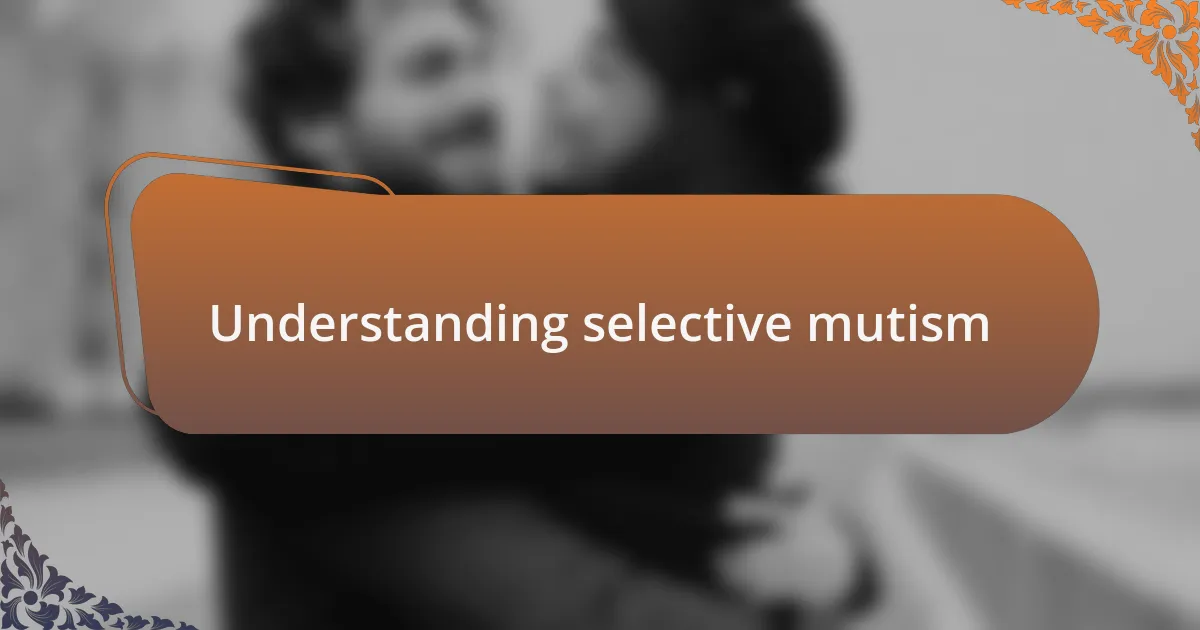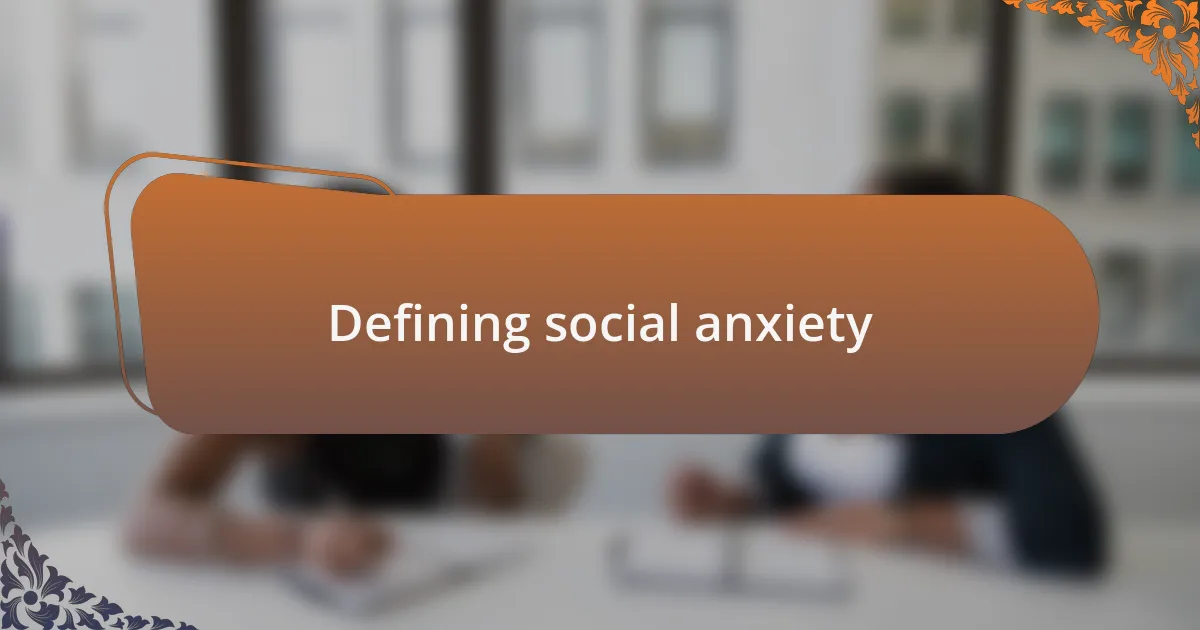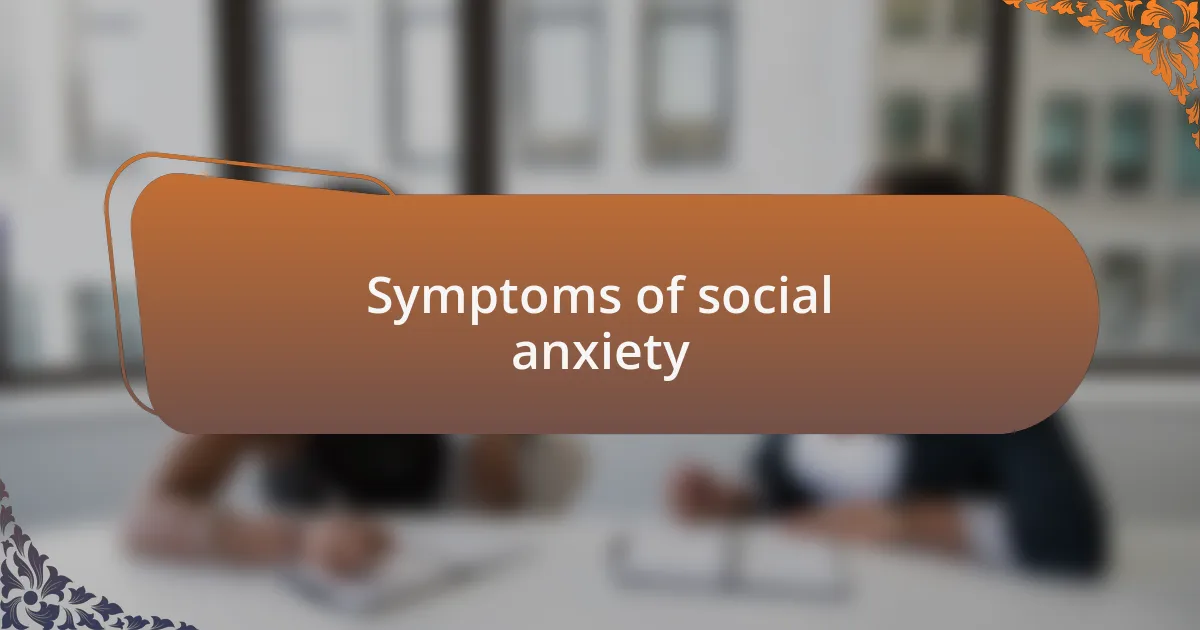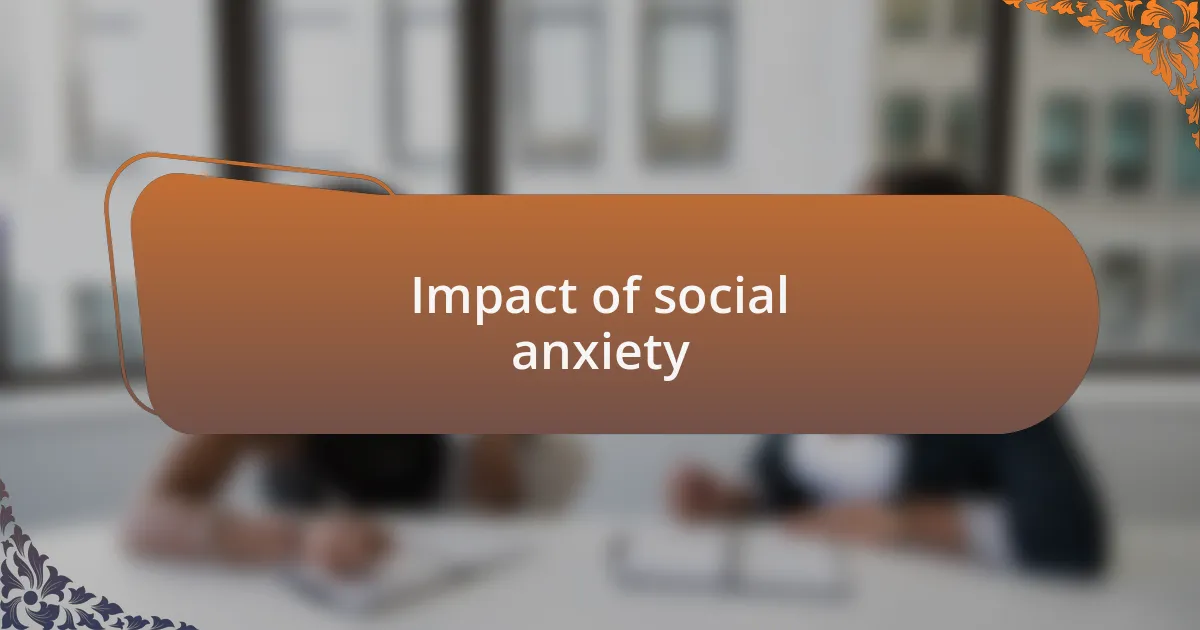Key takeaways:
- Selective mutism is a complex anxiety disorder that hinders verbal communication in specific social situations, often misunderstood as shyness.
- Social anxiety manifests through intense fear of judgment and can lead to physical symptoms, impacting everyday interactions and self-perception.
- Coping strategies such as journaling, visualization, and grounding techniques can help manage anxiety in social environments.
- Raising awareness about selective mutism is crucial for fostering understanding and empathy, encouraging open discussions about the condition.

Understanding selective mutism
Selective mutism is often misunderstood as mere shyness or stubbornness, but it is a complex anxiety disorder that affects a person’s ability to speak in certain social situations. I vividly recall a moment in elementary school when I wanted to speak up during a group project but felt completely paralyzed, as if my voice vanished. Have you ever felt that pit in your stomach when you wanted to say something but couldn’t find the words?
For many, like myself, selective mutism isn’t just about not speaking; it’s about the overwhelming weight of fear and anxiety that can make social interactions feel daunting. I remember avoiding gatherings, knowing my silence would draw attention, which ironically made me feel more isolated. It raises the question: how many people silently struggle, wishing they could break free from their invisible chains?
The experience can be so isolating that even those closest to us may not grasp the inner turmoil we face daily. I often wondered why I could speak freely at home yet felt dumbfounded around peers. It brings to light the complexities of our emotional landscape and the varying degrees of comfort we find in different environments. What if we could foster more understanding and connection around these feelings?

Defining social anxiety
Social anxiety is more than just feeling shy; it’s an overwhelming fear of judgment and scrutiny in social situations. I recall standing on the sidelines during a high school group presentation, my heart racing, wondering if everyone was judging me for not speaking. Have you ever felt the pressure to perform in a crowd, paralyzed by the fear of what others might think?
Often, this anxiety can manifest in physical symptoms, like sweating or trembling, which only amplifies the desire to retreat. I remember a specific moment at a family gathering where I longed to join conversations but felt as if invisible barriers held me back. It’s intriguing to think how a simple social setting can feel like a battlefield for those grappling with anxiety.
Defining social anxiety involves acknowledging its pervasive impact, shaping how we interact and perceive ourselves in the world. For me, the struggle often felt like an internal war, where thoughts raced with “What if I say something wrong?” and “What if I completely freeze up?” It begs the question: how might our experiences differ if social environments were more welcoming and understanding?

Symptoms of social anxiety
Social anxiety can lead to a whirlwind of emotions, often surfacing through physical symptoms. I remember attending a friend’s wedding, where I felt my palms sweat and my heart race just thinking about mingling with others. It’s fascinating how a smile can mask such turmoil, yet the fear of stumbling over words or being misunderstood looms large. Have you ever felt like you were trapped within your own body, silently screaming to escape?
Another symptom I have experienced is intense self-consciousness during conversations. I recall a moment when I mispronounced a word while chatting with a colleague, and the embarrassment washed over me like a tidal wave. In that instance, I wasn’t just worried about what they thought of me; I was gripped by the fear that every mistake would define how they viewed me forever. How often do we let small slips dictate our self-worth in social settings?
The emotional toll of social anxiety can be profound, often leading to a profound dread of upcoming events. I found that anticipating gatherings created a pit in my stomach days in advance. It’s odd, isn’t it? This anxiety can morph into a type of avoidance, where the thought of facing the world feels more daunting than staying home alone. How many opportunities for connection have I missed because of that overwhelming urge to withdraw?

Impact of social anxiety
Social anxiety shapes our experiences in ways that can be hard to fully grasp unless you’ve lived through it. For me, the simplest tasks, like making eye contact or initiating small talk, can feel like climbing a mountain. I’ve often left situations overwhelmed, thinking, “Why did I make it so hard on myself?” It raises a question: Can social gatherings ever be enjoyable when anxiety casts such a long shadow?
The impact extends beyond those immediate feelings; it often seeps into everyday life. I vividly recall a time when a casual outing with friends turned into a silent battle. While everyone around me laughed, I felt like an outsider, struggling to join in. In those moments, I wondered if my laughter would ever echo genuinely in my heart. Isn’t it fascinating how isolation can exist even in a crowd?
Moreover, I’ve noticed that social anxiety can create a cycle of avoidance that is tough to break. There were countless weekends when I declined invitations because the thought of socializing filled me with dread. Each declined invite felt like another brick added to the wall I was building around myself. What am I doing to myself by not pushing through that initial discomfort? As I reflect, it’s clear that the fear of judgment can sometimes keep us from building the very connections we crave.

My personal journey
I remember the first time I felt the grip of social anxiety. It was during a school presentation, and while everyone else seemed poised, my voice trembled and my palms sweated. Standing in front of my classmates, I couldn’t shake the feeling that every pair of eyes was scrutinizing my every move. That moment didn’t just feel embarrassing; it marked the beginning of a long, internal battle with my own confidence.
Looking back, one episode stands out vividly. I was at a family gathering, surrounded by relatives I’d known my whole life, yet I felt utterly invisible. As I watched others engage in lively conversations, a knot tightened in my stomach, whispering that I didn’t belong. Have you ever felt the weight of silence pressing on you like a heavy blanket? In those moments, I realized how deeply social anxiety could erode the simplest joys of connection.
Even now, I fight the urge to retreat in the face of social encounters. Recently, I attended a friend’s birthday party, and the dread was palpable. I felt like a ghost wandering among the living. But I took a deep breath and challenged myself to say just one thing, even if it was small. It was a small victory, but it reminded me that each step forward, no matter how tiny, is a part of reclaiming my voice in a world that often feels overwhelming.
Coping strategies I’ve used
One coping strategy I’ve found incredibly helpful is journaling. Writing down my thoughts provides an outlet for the whirlwind of emotions that can accompany social anxiety. I remember during a particularly stressful week, I took a few minutes each night to jot down my feelings. It was like unburdening my mind; suddenly, I could see my worries on paper and began to understand them better.
Another tactic is visualization. Before stepping into a social situation, I often picture myself navigating the interaction effortlessly. I recall a time when I had a meeting where I felt out of place. By picturing myself engaging confidently with my peers, it transformed my anxiety into excitement. Has visualization worked for you? It can truly change your perspective and ease your nerves when you need it most.
Lastly, grounding techniques have become a favorite of mine. Whenever anxiety strikes, I focus on my surroundings—what I can see, hear, and touch. At a recent gathering, I noticed the intricate patterns on the tablecloth and the laughter of friends mingling in the background. This simple practice anchored me in the moment and helped me reconnect, making the experience less overwhelming and more manageable.

Raising awareness about selective mutism
Raising awareness about selective mutism is essential, as many people still misunderstand or overlook this condition. I distinctly remember a time when a close friend didn’t grasp why I sometimes struggled to speak in large groups; their confusion highlighted how little many understand. It’s vital to share stories and experiences, so others can empathize and recognize that silence doesn’t stem from a lack of desire to communicate, but from deep-seated anxiety.
I believe education is a powerful tool in this process. I’ve seen firsthand how informative workshops can shed light on selective mutism for both teachers and peers. During one such session, I watched as participants began to connect the dots, realizing how impactful their responses could be. Have you ever witnessed a lightbulb moment when someone truly understands what you’re going through? It’s exhilarating and can make a world of difference for those affected.
Lastly, sharing personal experiences can break down barriers. When I discussed my journey with selective mutism on social media, I was taken aback by the outpouring of support and shared stories from others. It became clear that by raising our voices, we create a community of understanding, encouraging others to speak up about their struggles. Isn’t it fascinating how our personal narratives can resonate and create connections in unexpected ways?